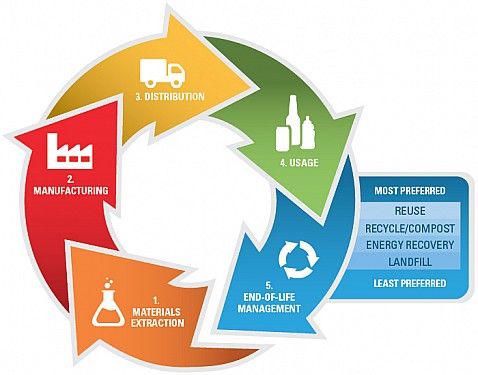January 31, 2017
Today’s Guest Blog is by Erich Lawson, an environmental blogger.
With the booming human population, the needs of the people also increase. There is one crucial question we need to ask ourselves – what if all the resources are exhausted, till there’s none left? The answer to this raises a question on our survival. It is precisely why we need to work on recycling better while also preserving our natural resources.
Sustainable Materials Management (SMM) is an approach which serves human needs by reusing resources constructively throughout their life cycles, while regularly reducing the amount of materials involved and all associated environmental impacts. Recycling decreases pollution while producing positive economic benefits. For instance, in 2014, 89 million tons of municipal solid garbage was recycled and composted. That’s equal to eliminating the CO2 emissions of 38 million passenger cars from the road, per year.
How our society utilizes materials is crucial to our economic and environmental future. The global conflict for our limited resources will only escalate as the world population and economies develop. A more fertile and less impactful use of materials will support our society to remain economically competitive, add to prosperity and guard the environment in a resource-constrained future.
Broad Policy Principles for SMM
1. Preserve Natural Capital
Natural capital is the source of supplies required to sustain life. It comprises natural resource stocks, land, atmosphere and ecosystems. Sustainable Materials Management can contribute to the conservation of natural capital. It can be preserved by enhancing resource productivity and reusing/recycling materials to such an extent that depletion of natural capital is reduced.
2. Design and direct materials for safety and sustainability from a life-cycle perspective
The life-cycle of a material includes its journey from extraction to disposal. The objective of this policy is to maximize positive environmental, financial and social outcomes across the complete life-cycle. Strengthened cooperation between various characters in the life-cycle is crucial, so that every actor is aware of the repercussions of his actions on other phases of the life-cycle. This helps the actor to work responsibly.
3. Use multiple aspects of the policy tools to stimulate and reinforce sustainable outcomes
Policy instruments which can stimulate SMM include regulations, economic incentives, trade, innovative policies, feedback and willing partnerships. Policies which augment each other habitually achieve more efficient, effective, impartial and enduring outcomes. The information contributing feedback on the full spectrum of policy impacts is critical, particularly because the policies can be altered appropriately.
4. Engage all sections of society
The collaboration of all stakeholders is a necessity for achieving SMM. Each party has an ethical obligation to make everyday decisions which propagate sustainable environmental, economic and social outcomes. Transparency in information is significant for stakeholders to be able to make choices that lead to a sustainable economy and a green planet. It is the ethical responsibility of each stakeholder to avoid actions which stir negative environmental impacts.
5. Recover More
•Recovering more value out of the resources economy is synergistically linked to the principle of using materials judiciously. By doing so the design issues affecting sourcing and the end-of-life concerns become aligned.
•Recycling reduces the need for virgin materials. By using recovered scrap substances (through recycling) instead of virgin ones, there is less need for forestry and mining practices both of which are detrimental to the environment.
•Recycling also saves energy as recycled materials consume less energy when manufactured as compared to the energy required while manufacturing new goods from raw materials.
Thus, through SMM, the power of recycling can help us build a greener future for ourselves and our future generations, by alleviating the stress on decreasing natural resources.
________________________________________________________________________
Erich Lawson is passionate about saving environment by effective recycling. He has written a wide array of articles on how modern recycling equipments can be used by industries to reduce monthly garbage bills and increase recycling revenue. You can learn more about environment savings techniques by visiting the Northern California Compactors, Inc. blog.
Sustainable Food Management is a priority area of EPA’s SMM Strategic Plan. EPA recently announced a new national virtual resource center dedicated to reducing food loss and waste: Further with Food: Center for Food Loss and Waste Solutions. The venture is the product of a public-private collaboration among the U.S. EPA, the U.S. Department of Agriculture, the Academy of Nutrition and Dietetics, Feeding America, the Food Marketing Institute, the Grocery Manufacturers Association, the Innovation Center for U.S. Diary, the National Consumers League, the National Restaurant Association, the Natural Resources Defense Council, the World Resources Institute, and the World Wildlife Fund, with additional funding and support from the Keystone Policy Center and the Rockefeller Foundation.
NERC welcomes Guest Blog submissions. To inquire about submitting articles contact Athena Lee Bradley, Projects Manager at athena(at)nerc.org. Disclaimer: Guest blogs represent the opinion of the writers and may not reflect the policy or position of the Northeast Recycling Council, Inc.



Comments (0)
Add a Comment